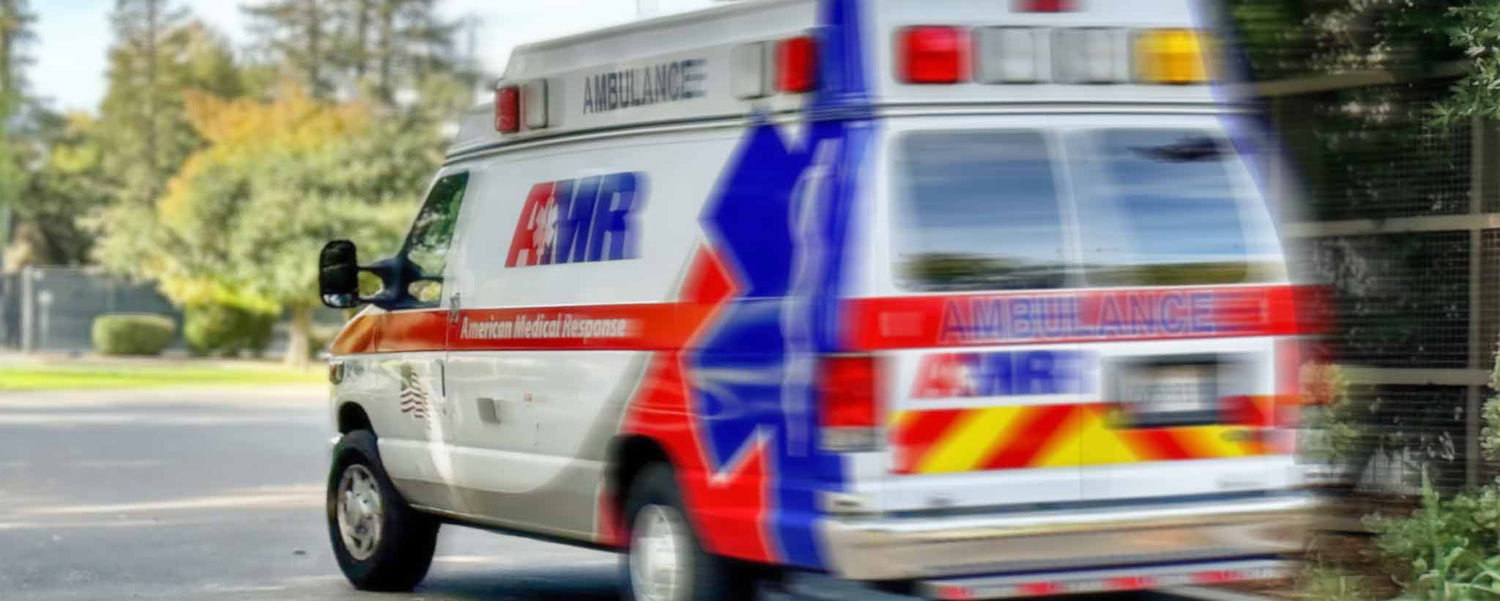The largest provider of ambulance services in the U.S. will halt some rides in Southern California, citing low Medicaid rates.
Ambulance Rides Just Got Tougher
For 23 years, the private ambulance industry in California had gone without an increase in the base rate the state pays it to transport Medicaid enrollees. At the start of the year, it asked the state legislature [1] to more than triple the rate, from around $110 to $350 per ride. The request went unheeded.
In September, American Medical Response, the largest U.S. provider of ambulance services, announced it had “made the difficult decision” [2] to end nonemergency transports in Los Angeles County and blamed the state for having one of the lowest Medicaid reimbursement rates in the country.
“What’s more,” the company, which sold for $2.4 billion [3] in 2017 to private equity firm KKR, [4] said, “we are not subsidized by taxpayer funds like public agencies, and almost 80% of our patients pay nothing or below cost for our services.”
The company, which also cited high operational costs, said its nonemergency division in that area was on track to lose $3.5 million in 2022.
Rates Stuck in 20th Century
The California Department of Health Care Services, which administers the state’s Medicaid program for low-income people, known as Medi-Cal, did not contest that the base rate hasn’t increased since 1999, but said that reimbursements have increased through add-on payments for supplemental costs [5] and emergency rides. [6]
In its initial announcement, AMR mentioned the phaseout of nonemergency services only in L.A. County. However, the company told KHN that it would stop servicing five hospitals in Orange County in addition to seven hospitals in L.A. County.
Jason Sorrick, vice president of government affairs at KKR-owned Global Medical Response, which is now AMR’s parent company, said AMR would exit over the next six months and shift vehicles and as many of the 170 crew members as possible to its core emergency services.
AMR’s pullout equates to a loss of 28,000 nonemergency transports a year and could create a predicament for the hospitals that contracted with the company. L.A. County said it does not track the total number of nonemergency rides provided by ambulances in the county, while Orange County wasn’t immediately able to share its figure.
Which Ambulance Services Are Affected?
Although ambulances are typically associated with 911 calls, many are used to transport frail or vulnerable patients between health care facilities. A patient may need to go to a rehabilitation facility after hip surgery, or someone who attempted suicide may need to be moved from an emergency room to a psychiatric facility. Such transfers, known as interfacility transports, enable hospitals to free up beds and maintain patient access.
There isn’t consensus on what the impact of AMR’s pullout will be. The state told KHN that it will review and address access issues on a “targeted basis” if it becomes aware of any. Patient advocates said it’s too early to draw conclusions about the effect on patients, particularly those covered by Medi-Cal. The California Ambulance Association flagged concerns that companies are already stretched thin by staffing and vehicle shortages.
Though the two counties and the insurers that serve their Medi-Cal populations did not express immediate concern about AMR’s decision, some hospitals may have trouble dealing with the loss.
“Halting these services will undoubtedly impact hospitals’ ability to efficiently manage” the flow of patients from arrival to discharge, said Adam Blackstone, senior vice president of communications for the Hospital Association of Southern California.
AMR said its pullout will primarily affect Providence, a Catholic health system operating in several states, including California. It did not respond to a request for comment.
AMR now also attributes its exit to avoiding a labor dispute. Sorrick said that because of Medi-Cal’s rates, AMR could not staff both emergency and nonemergency ambulances and raise wages for unionized emergency staffers who were threatening to strike. So it shuttered its lower-priority nonemergency division, which wasn’t unionized. It planned to use the savings to increase wages for emergency staff members.
Michael Diaz, an EMT and president of the International Association of EMTs and Paramedics Local 77, which represents 350 EMTs and paramedics for AMR emergency services in L.A. County, confirmed that AMR’s announcement came the day before the union planned to march in protest for higher wages.
Diaz, whose national union had joined the industry in lobbying the California legislature for higher rates, said AMR’s announcement could also have been politically motivated. “They’re sending a message,” he said.
So far, it’s unclear whether elected officials have noticed the pullout. Leaders of legislative budget committees declined to comment or did not respond to inquiries.
Medi-Cal spending on all medical transportation services totaled about $975 million in fiscal year 2021–22, according to data from the Department of Health Care Services.
The department said Medi-Cal’s insurers are ultimately responsible for maintaining an adequate network of medical transportation providers and noted that the insurers are allowed to pay above the base rate. The ambulance industry said it’s uncommon for insurers to pay more.
Who Picks Up the Slack?
Jimmy Pierson, president of the California Ambulance Association, said other ambulance companies usually pick up the slack when one exits a market. But he warned that competitors may not be able to cover all of AMR’s nonemergency ambulance rides this time, given unprecedented labor and supply shortages—including two-year waits for new ambulances [7]—and rising Medi-Cal enrollment and inflation. A recent national survey found that EMTs turned over at an annual rate of 36%. [8]
“How are you going to find 170 employees in a labor shortage?” Pierson asked. “How will you find those ambulances?”
Ambulance companies said that hiring and retention have been battered by low wages, burnout, and lasting effects of EMT school closures during the pandemic—and that low Medi-Cal reimbursements make paying EMTs competitive salaries difficult.
A few other companies in the state have already shut down or scaled back services, Pierson added. In 2016, AMR ended nonemergency and emergency services [9] in Tulare County, a region in the Central Valley with one of the highest [10] shares of residents on Medi-Cal.
Sorrick said AMR believes enough companies provide nonemergency transports to absorb the volume.
Chad Druten, president of the Los Angeles County Ambulance Association, said the county has approximately 1,200 licensed private ambulances operated by about 35 companies, [11] most of which are small to medium-sized and focus on nonemergency transports. A few large companies, including AMR, cover emergency calls.
Melissa Harris, who owns AmbuServe Ambulance Service in L.A. County, said she plans to compete for small portions of AMR’s contracts, focusing on the ones with fewer Medi-Cal patients. Harris said she loses money on every Medi-Cal-covered transport and can’t easily buy and staff new ambulances. If she wins any contracts, she will likely have to “trade” away her existing contracts that serve the highest portions of Medi-Cal patients.
The consequences of that, Harris said, would hit underserved patients the hardest.
To support the writing of useful articles about gerontology, ClinicalPosters sells human anatomy charts, scientific posters, and other products online. You may sponsor specific articles or remit a small donation.
ClinicalPosters sells human anatomy charts, scientific posters, and other products online to offset expense of the writing useful articles about gerontology. Slide extra posters into DeuPair Frames without removing from the wall.
Show your support by donating, shopping for ClinicalPins, or leaving an encouraging comment to keep the research going.
To support the writing of useful articles about gerontology, ClinicalPosters sells human anatomy charts, scientific posters, and other products online. You may sponsor specific articles or remit a small donation.
ClinicalPosters sells human anatomy charts, scientific posters, and other products online to offset expense of the writing useful articles about gerontology. Slide extra posters into DeuPair Frames without removing from the wall.
ClinicalPosters sells human anatomy charts, scientific posters, and other products online. You may remit a small donation.
You can support the writing of useful articles about gerontology by sponsoring specific articles or remitting a small donation. Visible content is optimized for device size.
KHN (Kaiser Health News) is a national newsroom that produces in-depth journalism about health issues. Together with Policy Analysis and Polling, KHN is one of the three major operating programs at KFF (Kaiser Family Foundation). KFF is an endowed nonprofit organization providing information on health issues to the nation.








 Romance & Health Intertwine. Fall in love with a captivating romance miniseries that explores the essence of well-being. Become a ClinicalNovellas member for heartwarming tales.
Romance & Health Intertwine. Fall in love with a captivating romance miniseries that explores the essence of well-being. Become a ClinicalNovellas member for heartwarming tales.




